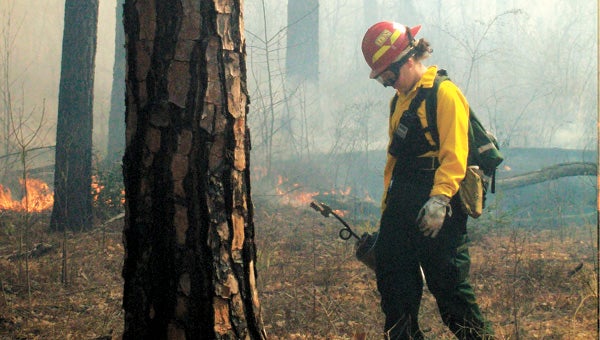AmeriCorps team helps at Great Dismal Swamp
Published 8:59 pm Monday, April 11, 2011

Phoenix One, the first of four AmeriCorps fire teams, was deployed in mid-March to help seasonal firefighters administer controlled burns in the Great Dismal Swamp.
An AmeriCorps National Civilian Community Corps team is working alongside seasonal firefighters in the Great Dismal Swamp this spring, administering controlled burns to create and maintain habitats for wildlife.
Phoenix One arrived in mid-March as the first of four teams that will complete six weeks of service at the swamp.
AmeriCorps NCCC is a 10-month program that provides young people with CPR, first aid, public safety and other skills training, and then sends them on a variety of assignments for the remainder of the program.
Rachel Lantz, a Phoenix One team member, said she decided to try out for the fire teams just to see if she could complete the pack test, which requires participants to travel three miles in 45 minutes while carrying a 45-pound pack on their backs.
The next thing she knew, Lantz was one of 40 who finished the test, and from there, all the members were broken up into four teams.
The team members are required to do a month-long training in the community and another week of specialty training, teaching them techniques they would use while participating in the burns.
“There’s a lot of information that goes into firefighting,” she said.
Lantz said they learned everything from using their tools to how to check humidity.
They also learned how to gauge the weather because it has a big impact on how much work the fire teams get done.
Lantz said the changes in temperature and abundance of precipitation the area has seen lately have made it harder to have controlled burns.
If it is too hot outside, the brush, leaves and grass might be too dry to have a manageable burn, she said.
Even with the weather, Phoenix One has participated in three burns in the past week, Lantz said.
Many of the burns that take place are designed to help the habitats of animals.
In the team’s last burn, 63 acres of grasslands were burnt to create better nesting environments for birds, especially for the endangered red-cockaded woodpecker.
Controlled burns can be various sizes, Lantz said. The team has participated in one that was 42 acres and another that was 69 acres.
“They are big to us, but we’ve been told there are way bigger burns,” she said, citing a 6,000-acre burn that took place in western Virginia recently.
Along with being a part of controlled burns, the team can also be called upon if a wildfire breaks out suddenly, Lantz said.
“If there is a wildfire and they ask for assistance, they will put together teams,” she said.
While wildfires can’t be predicted, Lantz said the chances increase if there is extreme weather and a lot of wildfires in the west.
One of the purposes of controlled burns is to keep wildfires in check if they do break out.
“It helps prevent wild fires from being huge and monstrous,” she said.
For Phoenix One members, every burn is another one under their belts.
The more experience the members have, they better they get at being firefighters, Lantz said.
Even after their time in the swamp is over, the team members want to continue to learn about firefighting, she said.
For Lantz, an experience that started with “Can I?” has turned into a opportunity of “I can.”
She has enjoyed being a part of Phoenix One so much she wants to continue firefighting. Her certification as a seasonal firefighter lasts until next March. She said she will then get recertified.
“I’ve already learned so much, and it’s basically just started,” Lantz said.
Phoenix One will be in the Great Dismal Swamp until April 22, at which time a new team will take its place.






